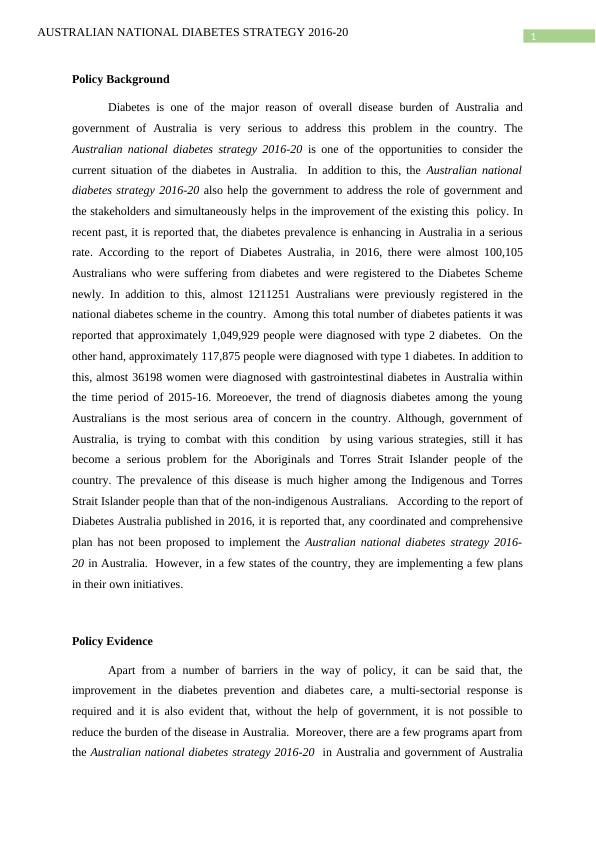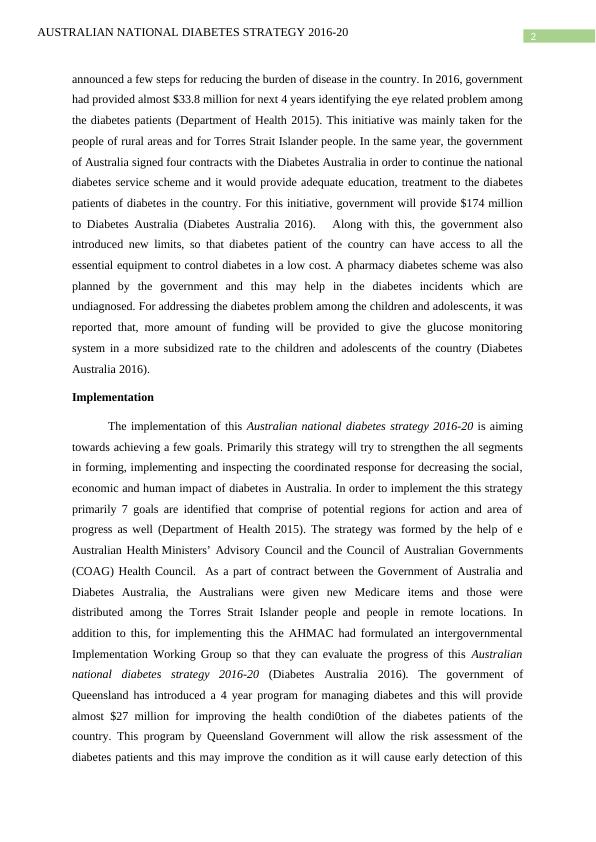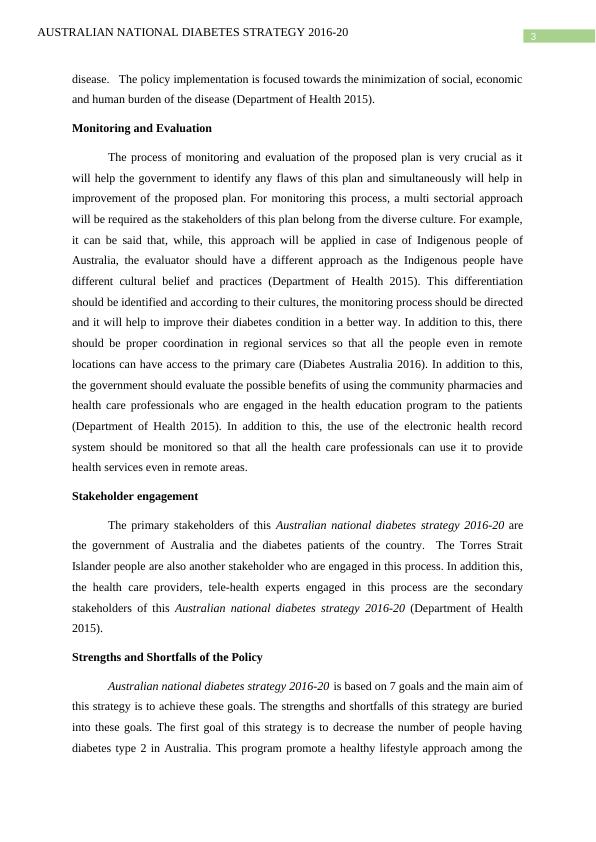Australian National Diabetes Strategy 2016-20
Added on 2023-03-17
11 Pages3602 Words75 Views
Running head: AUSTRALIAN NATIONAL DIABETES STRATEGY 2016-20
Australian National Diabetes Strategy 2016-20
Course Name and Number
Name of the coordinator
Name of the Student
Name of the University
Author Note
Australian National Diabetes Strategy 2016-20
Course Name and Number
Name of the coordinator
Name of the Student
Name of the University
Author Note

1AUSTRALIAN NATIONAL DIABETES STRATEGY 2016-20
Policy Background
Diabetes is one of the major reason of overall disease burden of Australia and
government of Australia is very serious to address this problem in the country. The
Australian national diabetes strategy 2016-20 is one of the opportunities to consider the
current situation of the diabetes in Australia. In addition to this, the Australian national
diabetes strategy 2016-20 also help the government to address the role of government and
the stakeholders and simultaneously helps in the improvement of the existing this policy. In
recent past, it is reported that, the diabetes prevalence is enhancing in Australia in a serious
rate. According to the report of Diabetes Australia, in 2016, there were almost 100,105
Australians who were suffering from diabetes and were registered to the Diabetes Scheme
newly. In addition to this, almost 1211251 Australians were previously registered in the
national diabetes scheme in the country. Among this total number of diabetes patients it was
reported that approximately 1,049,929 people were diagnosed with type 2 diabetes. On the
other hand, approximately 117,875 people were diagnosed with type 1 diabetes. In addition to
this, almost 36198 women were diagnosed with gastrointestinal diabetes in Australia within
the time period of 2015-16. Moreoever, the trend of diagnosis diabetes among the young
Australians is the most serious area of concern in the country. Although, government of
Australia, is trying to combat with this condition by using various strategies, still it has
become a serious problem for the Aboriginals and Torres Strait Islander people of the
country. The prevalence of this disease is much higher among the Indigenous and Torres
Strait Islander people than that of the non-indigenous Australians. According to the report of
Diabetes Australia published in 2016, it is reported that, any coordinated and comprehensive
plan has not been proposed to implement the Australian national diabetes strategy 2016-
20 in Australia. However, in a few states of the country, they are implementing a few plans
in their own initiatives.
Policy Evidence
Apart from a number of barriers in the way of policy, it can be said that, the
improvement in the diabetes prevention and diabetes care, a multi-sectorial response is
required and it is also evident that, without the help of government, it is not possible to
reduce the burden of the disease in Australia. Moreover, there are a few programs apart from
the Australian national diabetes strategy 2016-20 in Australia and government of Australia
Policy Background
Diabetes is one of the major reason of overall disease burden of Australia and
government of Australia is very serious to address this problem in the country. The
Australian national diabetes strategy 2016-20 is one of the opportunities to consider the
current situation of the diabetes in Australia. In addition to this, the Australian national
diabetes strategy 2016-20 also help the government to address the role of government and
the stakeholders and simultaneously helps in the improvement of the existing this policy. In
recent past, it is reported that, the diabetes prevalence is enhancing in Australia in a serious
rate. According to the report of Diabetes Australia, in 2016, there were almost 100,105
Australians who were suffering from diabetes and were registered to the Diabetes Scheme
newly. In addition to this, almost 1211251 Australians were previously registered in the
national diabetes scheme in the country. Among this total number of diabetes patients it was
reported that approximately 1,049,929 people were diagnosed with type 2 diabetes. On the
other hand, approximately 117,875 people were diagnosed with type 1 diabetes. In addition to
this, almost 36198 women were diagnosed with gastrointestinal diabetes in Australia within
the time period of 2015-16. Moreoever, the trend of diagnosis diabetes among the young
Australians is the most serious area of concern in the country. Although, government of
Australia, is trying to combat with this condition by using various strategies, still it has
become a serious problem for the Aboriginals and Torres Strait Islander people of the
country. The prevalence of this disease is much higher among the Indigenous and Torres
Strait Islander people than that of the non-indigenous Australians. According to the report of
Diabetes Australia published in 2016, it is reported that, any coordinated and comprehensive
plan has not been proposed to implement the Australian national diabetes strategy 2016-
20 in Australia. However, in a few states of the country, they are implementing a few plans
in their own initiatives.
Policy Evidence
Apart from a number of barriers in the way of policy, it can be said that, the
improvement in the diabetes prevention and diabetes care, a multi-sectorial response is
required and it is also evident that, without the help of government, it is not possible to
reduce the burden of the disease in Australia. Moreover, there are a few programs apart from
the Australian national diabetes strategy 2016-20 in Australia and government of Australia

2AUSTRALIAN NATIONAL DIABETES STRATEGY 2016-20
announced a few steps for reducing the burden of disease in the country. In 2016, government
had provided almost $33.8 million for next 4 years identifying the eye related problem among
the diabetes patients (Department of Health 2015). This initiative was mainly taken for the
people of rural areas and for Torres Strait Islander people. In the same year, the government
of Australia signed four contracts with the Diabetes Australia in order to continue the national
diabetes service scheme and it would provide adequate education, treatment to the diabetes
patients of diabetes in the country. For this initiative, government will provide $174 million
to Diabetes Australia (Diabetes Australia 2016). Along with this, the government also
introduced new limits, so that diabetes patient of the country can have access to all the
essential equipment to control diabetes in a low cost. A pharmacy diabetes scheme was also
planned by the government and this may help in the diabetes incidents which are
undiagnosed. For addressing the diabetes problem among the children and adolescents, it was
reported that, more amount of funding will be provided to give the glucose monitoring
system in a more subsidized rate to the children and adolescents of the country (Diabetes
Australia 2016).
Implementation
The implementation of this Australian national diabetes strategy 2016-20 is aiming
towards achieving a few goals. Primarily this strategy will try to strengthen the all segments
in forming, implementing and inspecting the coordinated response for decreasing the social,
economic and human impact of diabetes in Australia. In order to implement the this strategy
primarily 7 goals are identified that comprise of potential regions for action and area of
progress as well (Department of Health 2015). The strategy was formed by the help of e
Australian Health Ministers’ Advisory Council and the Council of Australian Governments
(COAG) Health Council. As a part of contract between the Government of Australia and
Diabetes Australia, the Australians were given new Medicare items and those were
distributed among the Torres Strait Islander people and people in remote locations. In
addition to this, for implementing this the AHMAC had formulated an intergovernmental
Implementation Working Group so that they can evaluate the progress of this Australian
national diabetes strategy 2016-20 (Diabetes Australia 2016). The government of
Queensland has introduced a 4 year program for managing diabetes and this will provide
almost $27 million for improving the health condi0tion of the diabetes patients of the
country. This program by Queensland Government will allow the risk assessment of the
diabetes patients and this may improve the condition as it will cause early detection of this
announced a few steps for reducing the burden of disease in the country. In 2016, government
had provided almost $33.8 million for next 4 years identifying the eye related problem among
the diabetes patients (Department of Health 2015). This initiative was mainly taken for the
people of rural areas and for Torres Strait Islander people. In the same year, the government
of Australia signed four contracts with the Diabetes Australia in order to continue the national
diabetes service scheme and it would provide adequate education, treatment to the diabetes
patients of diabetes in the country. For this initiative, government will provide $174 million
to Diabetes Australia (Diabetes Australia 2016). Along with this, the government also
introduced new limits, so that diabetes patient of the country can have access to all the
essential equipment to control diabetes in a low cost. A pharmacy diabetes scheme was also
planned by the government and this may help in the diabetes incidents which are
undiagnosed. For addressing the diabetes problem among the children and adolescents, it was
reported that, more amount of funding will be provided to give the glucose monitoring
system in a more subsidized rate to the children and adolescents of the country (Diabetes
Australia 2016).
Implementation
The implementation of this Australian national diabetes strategy 2016-20 is aiming
towards achieving a few goals. Primarily this strategy will try to strengthen the all segments
in forming, implementing and inspecting the coordinated response for decreasing the social,
economic and human impact of diabetes in Australia. In order to implement the this strategy
primarily 7 goals are identified that comprise of potential regions for action and area of
progress as well (Department of Health 2015). The strategy was formed by the help of e
Australian Health Ministers’ Advisory Council and the Council of Australian Governments
(COAG) Health Council. As a part of contract between the Government of Australia and
Diabetes Australia, the Australians were given new Medicare items and those were
distributed among the Torres Strait Islander people and people in remote locations. In
addition to this, for implementing this the AHMAC had formulated an intergovernmental
Implementation Working Group so that they can evaluate the progress of this Australian
national diabetes strategy 2016-20 (Diabetes Australia 2016). The government of
Queensland has introduced a 4 year program for managing diabetes and this will provide
almost $27 million for improving the health condi0tion of the diabetes patients of the
country. This program by Queensland Government will allow the risk assessment of the
diabetes patients and this may improve the condition as it will cause early detection of this

3AUSTRALIAN NATIONAL DIABETES STRATEGY 2016-20
disease. The policy implementation is focused towards the minimization of social, economic
and human burden of the disease (Department of Health 2015).
Monitoring and Evaluation
The process of monitoring and evaluation of the proposed plan is very crucial as it
will help the government to identify any flaws of this plan and simultaneously will help in
improvement of the proposed plan. For monitoring this process, a multi sectorial approach
will be required as the stakeholders of this plan belong from the diverse culture. For example,
it can be said that, while, this approach will be applied in case of Indigenous people of
Australia, the evaluator should have a different approach as the Indigenous people have
different cultural belief and practices (Department of Health 2015). This differentiation
should be identified and according to their cultures, the monitoring process should be directed
and it will help to improve their diabetes condition in a better way. In addition to this, there
should be proper coordination in regional services so that all the people even in remote
locations can have access to the primary care (Diabetes Australia 2016). In addition to this,
the government should evaluate the possible benefits of using the community pharmacies and
health care professionals who are engaged in the health education program to the patients
(Department of Health 2015). In addition to this, the use of the electronic health record
system should be monitored so that all the health care professionals can use it to provide
health services even in remote areas.
Stakeholder engagement
The primary stakeholders of this Australian national diabetes strategy 2016-20 are
the government of Australia and the diabetes patients of the country. The Torres Strait
Islander people are also another stakeholder who are engaged in this process. In addition this,
the health care providers, tele-health experts engaged in this process are the secondary
stakeholders of this Australian national diabetes strategy 2016-20 (Department of Health
2015).
Strengths and Shortfalls of the Policy
Australian national diabetes strategy 2016-20 is based on 7 goals and the main aim of
this strategy is to achieve these goals. The strengths and shortfalls of this strategy are buried
into these goals. The first goal of this strategy is to decrease the number of people having
diabetes type 2 in Australia. This program promote a healthy lifestyle approach among the
disease. The policy implementation is focused towards the minimization of social, economic
and human burden of the disease (Department of Health 2015).
Monitoring and Evaluation
The process of monitoring and evaluation of the proposed plan is very crucial as it
will help the government to identify any flaws of this plan and simultaneously will help in
improvement of the proposed plan. For monitoring this process, a multi sectorial approach
will be required as the stakeholders of this plan belong from the diverse culture. For example,
it can be said that, while, this approach will be applied in case of Indigenous people of
Australia, the evaluator should have a different approach as the Indigenous people have
different cultural belief and practices (Department of Health 2015). This differentiation
should be identified and according to their cultures, the monitoring process should be directed
and it will help to improve their diabetes condition in a better way. In addition to this, there
should be proper coordination in regional services so that all the people even in remote
locations can have access to the primary care (Diabetes Australia 2016). In addition to this,
the government should evaluate the possible benefits of using the community pharmacies and
health care professionals who are engaged in the health education program to the patients
(Department of Health 2015). In addition to this, the use of the electronic health record
system should be monitored so that all the health care professionals can use it to provide
health services even in remote areas.
Stakeholder engagement
The primary stakeholders of this Australian national diabetes strategy 2016-20 are
the government of Australia and the diabetes patients of the country. The Torres Strait
Islander people are also another stakeholder who are engaged in this process. In addition this,
the health care providers, tele-health experts engaged in this process are the secondary
stakeholders of this Australian national diabetes strategy 2016-20 (Department of Health
2015).
Strengths and Shortfalls of the Policy
Australian national diabetes strategy 2016-20 is based on 7 goals and the main aim of
this strategy is to achieve these goals. The strengths and shortfalls of this strategy are buried
into these goals. The first goal of this strategy is to decrease the number of people having
diabetes type 2 in Australia. This program promote a healthy lifestyle approach among the

End of preview
Want to access all the pages? Upload your documents or become a member.
Related Documents
Closing the Gap Policy and its Significance to Indigenous Australianslg...
|9
|2301
|364
The sociological imagination templatelg...
|11
|2654
|47
Diabetes Mellitus Australia Research Paper 2022lg...
|8
|2400
|35
Chronic Kidney Disease among Aboriginal and Torres Strait Islander Peoplelg...
|7
|2496
|199
Health Complication Among the Indigenous People.lg...
|7
|1851
|16
Public Health Assignment 2022lg...
|9
|1957
|27
